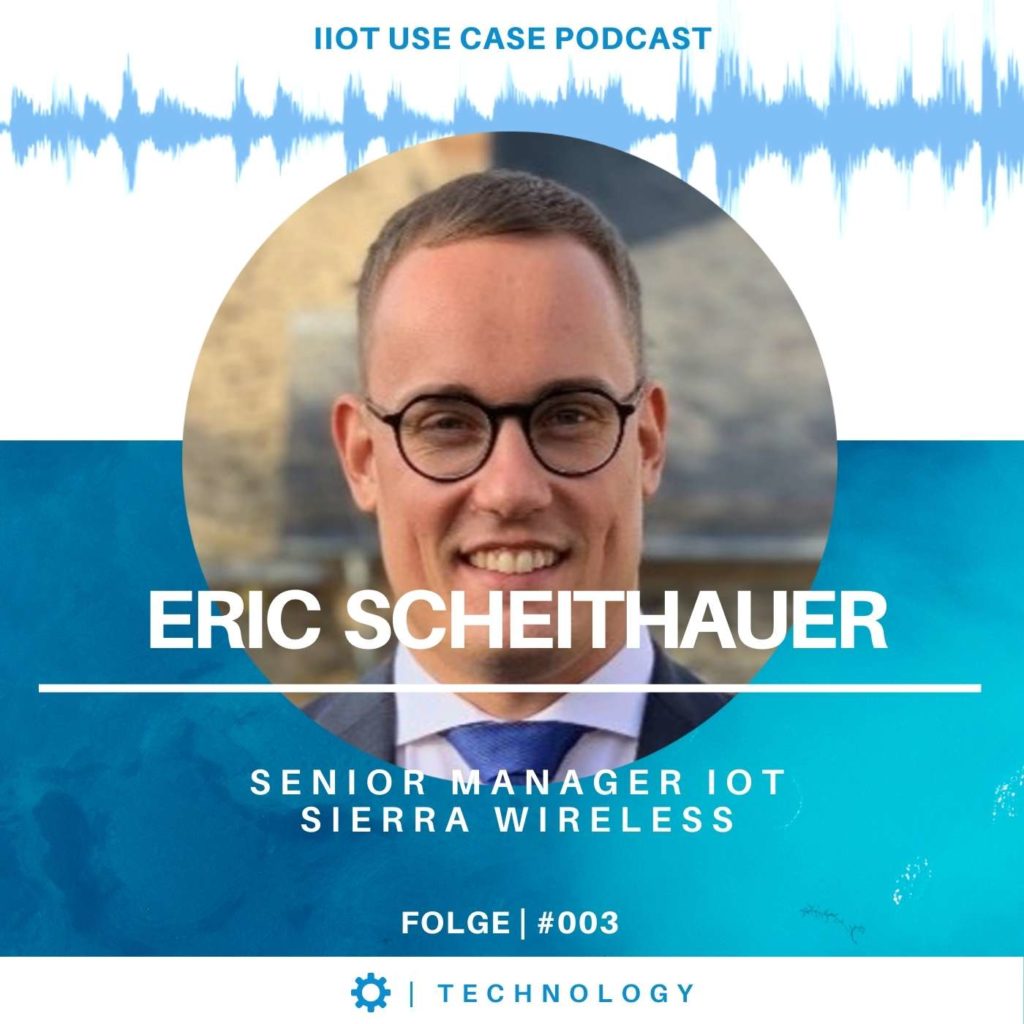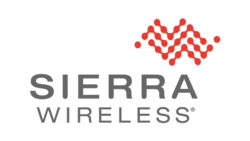In this podcast episode, Eric Scheithauer, Senior Industry Solutions Manager IoT at Sierra Wireless, introduces us to the networking concepts of LPWAN, LTE-M, LoRaWAN and NB-IoT. With these technologies, fast, cost-effective and energy-saving solutions for IoT use cases can be implemented. He talks about LTE-M and NB-IoT network coverage, sensors, IoT protocols, cloud interfaces and 5G.
Explained | LPWAN, LTE-M, NB-IoT, LoRa, 5G
Eric first explains how the individual networking concepts are to be classified in the overall concept of Industrial IoT. Low Power Wide Area Network (LPWAN) is a class of IoT networking protocols where high network coverage or range and low power consumption are the key criteria for networking IoT end devices.[Source.]
Along with LTE-M and NB-IoT, LoRaWAN is another representative of the LPWAN (low-power wide-area network) family for wireless communication in a regional, national or even global network. In this context, LTE-M and NB-IoT meet the most important requirements of the IoT – Internet of Things – such as secure and bidirectional real-time communication, localization and mobility of devices, end-to-end encryption, worldwide availability, as well as future-proofing (backward compatibility) through global standards (3GPP) recognized and implemented by manufacturers and network operators alike.
In this IIoT Use Case Podcast episode, we also go into the differences between LTE-M and NB-IoT (3GPP) vs. LoRa. The differences Sigfox vs. LoRa are also relevant in this course. The New Networks for NB-IoT and LTE-M offer customers broad opportunities to implement Industrial IoT use cases. Long Term Evolution for Machines (LTE-M) and NarrowBand IoT (NB-IoT) are radio technologies developed specifically for the Internet of Things (IoT). During the conversation, Eric elaborates on the range of data transmission from sensors and other IoT devices using these technologies standardized by the 3rd Generation Partnership Project (3GPP).
LTE-M and NB-IoT rely on existing cellular networks and enable devices and machines to be connected with high network coverage and very low power requirements.[Source]
Eric explains how Octave, Sierra Wireless’ all-in-one edge-to-cloud solution, is used to connect industrial IoT devices in the field directly to the customer’s cloud platform via an API.
LTE-M and NB-IoT are globally standardized LPWA (Low Power Wide Area Network) technologies developed by 3GPP with a view to the 5G standard and are therefore to be classified as 5G technologies, in contrast to e. g. LTE-M and NB-IoT. the proprietary LoRaWAN or Sigfox.
The 3rd Generation Partnership Project (3GPP) is the worldwide cooperation of standardization bodies for the standardization of mobile technologies such as 2G, 3G, 4G/LTE and 5G.[Source]
Eric goes into what LTE-M means and the differences that arise from comparing LTE-M vs. NB-IoT. We also briefly address the LTE-M network coverage in this context. The transmission technologies are designed to meet the needs of IoT solutions and are the optimal technologies for enterprises to realize any imaginable IoT scenario, driving digital transformation in any industry.
LTE-M is the most suitable and fastest form of LPWA IoT communication and is recommended for both stationary and mobile IoT use cases due to standardized global roaming and support of real-time communication like voice through low latencies, where comparatively higher bandwidth (375Kbps vs. NB-IoT 65Kbps vs. LoRa 22Kbps) is required to transmit data, very high network coverage is desired (10x more than LTE), a stable signal should be ensured even through concrete walls or metal down to the basement, and where at the same time very low energy consumption (100x less than LTE; battery operation 10+ years) and low costs play a supporting role (50% lower than LTE).
Supporting up to 1. million connected devices per square kilometer, LTE-M is ideally suited for all use cases, from sensors, building automation, elevators, smart cities, compressors, pumps, smart meters and energy storage, to trackers, wearables and much more.[Source]
Market Position | Sierra Wireless
In the Industrial IoT environment, Sierra Wireless is relying heavily on LTE-M as an established, standardized and future-proof (5G-ready) technology due to the aforementioned advantages over NB-IoT and LoRa. Eric explains to us that in IoT use cases, high data rates are often not necessary and therefore LPWA is often used. In addition, we briefly touch on the topic of voice transmission in Industrial IoT use cases. It is expected that voice transmission will become more important in the future, especially when it comes to human interaction with machines. As an example, Eric gives us a use case where voice authentication is to be used to open gates or even vehicles.
Eric talks about how IoT edge assets (sensors, controllers, machines, etc.) are securely and easily connected to the cloud via each of the networking concepts. Using various use cases, he also explains how, for example, global SIM cards (including roaming) are made available and which regulations must be complied with in this context, also in connection with 5G.
Eric explains which institutions are working on which standards and which will become increasingly important in the IoT environment in the future. We will look at different use cases to understand how these concepts work together with the cloud. In addition, we talk about how Sierra Wireless’ offering and technologies fit into the so-called “IoT stack.” From the top application layer, where business apps and dashboards are developed, to the data layer, where cloud services and (Big Data) analytics run, to the edge level, where connectivity such as cellular networks and IoT gateways that connect to devices in the field (“edge assets”) reside. Sierra Wireless is a complete provider of IoT edge/device-to-cloud solutions, covering the entire range from connecting the field device to IoT edge gateways using common industry protocols, to cellular modules and connectivity (global SIM, own cellular network), services for SIM and device management and data orchestration, to interfaces to the customer cloud via cloud connectors and standardized cloud APIs.
For the data layer, Sierra Wireless provides so-called REST APIs as interfaces for integration into the customer’s existing cloud infrastructure. In this context, Eric also explains to us what REST-API interfaces are and what they mean for the implementation of IIoT use cases. REST API stands for “Representational State Transfer – Application Programming Interface.” It makes the simple, fast and secure bidirectional exchange of information between different (cloud) systems possible. [Source]
Use Cases | Industrial IoT
We talk about different use cases. One is a fan manufacturer that wants to prevent unplanned downtime by connecting to the cloud with remote monitoring. Since fans can be critical to maintaining continuous production for the customer, a shutdown can mean a loss of production of anywhere from several days to weeks, depending on the equipment and process. Eric explains to us how Sierra Wireless is addressing this real-world use case with the customer. The data can be read directly from the controller (PLC) via common industrial protocols (Modbus, CANopen, etc.) using the IoT gateway, transmitted via the mobile network (LTE-M, global SIM) and fed directly into the customer’s cloud platform (via REST API, cloud connectors) so that the customer can process the data accordingly, e. g. for analyses and remote monitoring.
As the conversation continues, I ask Eric how important ecosystems and partnerships are to Sierra Wireless. He elaborates that success often depends on a good interplay of powerful partnerships. This is particularly important in the IoT environment, where projects are often extremely difficult for a single company to manage on its own due to the complexity and variety of expertise required in a wide range of areas. Especially if the company has never implemented an IoT project before. The choice of local, regional and international partnerships with the appropriate industry and technology focus is essential. In its Industrial IoT projects, Sierra Wireless works with Microsoft Azure as a cloud computing platform, for example, as well as other partners – but also supports all common cloud systems such as AWS, Google, SAP and IBM.
We also talk about the topic of 5G and its importance in terms of Industrial IoT use cases. Projects that involve private networks are particularly exciting, explains Eric. As an example of a use case, Eric mentions the company “BASF SE”, which has high data transmission rates due to video or voice applications in its private network. Use cases around autonomous driving with real-time data are also 5G use cases. Low latency, i.e. low delay of the data packets, is important here. For IoT use cases in the Low Power Wide Area Network (LTE-M, NB-IoT), the data rates are often lower, and slightly higher latencies are usually not a problem there, since the devices usually do not move as fast. As an example use case, Eric cites tracking applications to track containers, boxes and packages. Monitoring cold chains of critical goods is also a widespread use case in the pharmaceutical environment. Critical goods can be, for example, medicines or (COVID-19) vaccines, for which compliance with the cold chain must be fully traceable in order to be able to guarantee the effectiveness of the vaccine at all times when it arrives at the hospital, or at the doctor’s office. The same applies to blood samples, which may only be subject to minor temperature fluctuations until they arrive at their destination.
Another use case is a project of the company Atlas Copco, which is divided into the group divisions Compressor Technology, Industrial Technology (with tools and assembly systems), Construction Technology and Mining Technology. In the field of compressor technology, Atlas Copco initially wanted to monitor the condition of the compressors at the customer’s site in the field in the IoT use case. In particular, data such as the number of operating hours, temperature, pressure, speed and volume flow should be monitored. Such a use case can be successfully implemented using Octave, Sierra Wireless’ all-in-one edge-to-cloud solution. However, the company has gone one step further and developed a new consumption-based business model to increase customer loyalty and position itself as even more customer-friendly. Now it is no longer the compressor as such that is sold (CAPEX), but the generation of compressed air (OPEX). Consumption billing is fully automated for the customer through the IoT networking of the compressor. On the one hand, Atlas Copco thus achieves significant efficiency gains through a higher degree of automation, and on the other, the customer obtains complete cost transparency at all times based on usage-based billing of the compressed air it consumes. In the area of energy storage solutions (battery storage), a use case was also implemented to monitor chemical and electrical operating parameters of battery storage systems. Here, both the hydrogen content of the air in the battery container, which can increase during the operation of lead-acid batteries and thus pose an explosion hazard, and the functionality of the air conditioning system for a constant operating temperature and the voltage and current strength of the individual battery cells are monitored. Since the availability and full operational capability of battery storage is extremely important, especially for stabilizing the power grid during peak loads, or for storing excess energy from wind power or photovoltaic plants, e. g. at night when consumption is lower, IoT-based remote monitoring solutions are used here. Sierra Wireless also successfully implemented this use case with the customer in a very short time using the Octave complete IoT solution. Eric presents one last use case toward the end in the area of air purifiers and air quality for a safe and clean environment. Here, the focus is on application fields in hospitals, clean rooms, laboratories as well as smoking cabins at airports, for example. In the manufacturing process of drugs, semiconductors or food, the assurance and continuous monitoring of a clean or pure environment is of utmost relevance. Here, too, Sierra Wireless relies on the Octave IoT all-round carefree package. In addition to the IoT gateway with integrated cellular module and SIM card, this includes support for common industrial protocols, access to the global cellular network, and provides services for SIM and device management as well as the necessary cloud connectors and standardized cloud APIs. Using the possibilities of intelligent edge processing by means of rules, filters, and logics, measured parameters can already be pre-processed in the field in the Octave IoT gateways in order to send them to the customer’s cloud afterwards. Operating parameters of the air purification systems such as operating hours, speed, air pressure, humidity, and particle concentration are used to monitor the air quality, condition, and effectiveness of the system at all times, and to troubleshoot and plan maintenance in advance via remote monitoring . For example, if the temperature in the bearing of the fan of the equipment increases, then this may indicate wear of the bearing and require maintenance. Here, the collected data is useful to detect this very long before a fan failure – and thus the failure of the entire air purification system – and to arrange maintenance by a service technician at an early stage and schedule it into the production flow. The topic of retro-fit also plays a role for Sierra Wireless: solutions based on already globally certified hardware such as IoT gateways, which can be connected directly to the control system of the plant, for example, or to built-in sensors, are particularly suitable for this purpose in order to transfer the data simply, quickly and, above all, securely to any cloud. In order to bring their IoT project to market quickly, many customers choose the gateway approach and especially appreciate the flexibility to cover both new installations and retrofit applications, and benefit from reduced complexity and time of the IoT project due to already certified and fully integrated solutions, without having to worry much about the necessary IoT infrastructure or the costly or lengthy build-up of internal competencies for system integration, cybersecurity, and mobile technologies in order to be able to start an IoT project at all. But there are also customers who like to develop their own design. They then usually rely on a solution based on a globally certified mobile communications module, which they integrate into their product, e. g. a control system or an IoT box, either alone or together with partners. Of course, this approach also has advantages, but requires special know-how as well as the corresponding human resources. Eric elaborates that there are, however, many different approaches and procedures here that can equally lead to success.
About the make or buy decision, ecosystems and ROI
In this context, Eric also speaks briefly on the topic of the “make or buy” question. Do I develop the solution myself as a company or do I look for a competent partner to help me? He answers the question accordingly through Sierra Wireless’ IoT core competency and IoT solution portfolio and discusses the pros and cons. In addition, Eric points to Forrester Research’s study, “The Total Economic Impact of Sierra Wireless Octave,” which shows that customers using the Octave IoT solution can achieve up to 88% ROI (return on investment) and a ~9-month reduction in time-to-market for their IoT project.
At the end, we talk about ROI (return on investment) and subscription models, where I pay monthly for services such as cloud resources. Eric explains that it is important for customers to only pay for what is currently needed or used and also to deploy a future-proof solution that can be expanded and scaled globally as needed. At this point, Sierra Wireless offers consulting services as well as customized solutions for a wide variety of use cases and customer requirements. So if requirements change, I want to be able to quickly add certain services or maybe build my own apps that I can customize as needed. Depending on the learning curve and use case, the needs here are different.
In Looking Ahead, Eric addresses the issue of the availability of diminishing talent and resources in Germany – particularly in the cyber security and IT environment, as well as the opportunities and risks this presents. He talks about cybersecurity as the basis for successful IoT projects and the importance of cross-sector collaboration and powerful (partner) ecosystems, but also with regard to standardization of protocols. As examples, he mentions OPC UA (OPC Unified Architecture is a standard for data exchange as a platform-independent, service-oriented architecture) and IO-Link (IO-Link is the first globally standardized IO technology (IEC 61131-9)), so that in the future all types of machines and sensors will be able to communicate with each other at the lowest possible cost and in a scalable manner. The solution I implement today for my IoT project must be ready for the future so that I can also successfully implement new use cases that are gaining relevance as a result of the ongoing digital transformation and not have to start from scratch again.
Sierra Wireless is an IoT pioneer, empowering businesses and industries to transform and thrive in the connected economy. Sierra Wireless offers a device-to-cloud solution consisting of embedded networking solutions that are seamlessly integrated with its secure cloud and connectivity service. OEMs and enterprises worldwide rely on Sierra Wireless’ expertise in delivering fully integrated solutions to reduce complexity, turn data into information, and bring their connected products and services to market faster. Sierra Wireless employs more than 1,300 people worldwide and operates research and development centers in North America, Europe and Asia.










